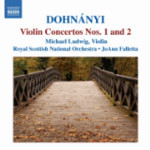
Dohnanyi: Violin Concertos Nos 1 & 2
 $25.00
Out of Stock
$25.00
Out of Stock6+ weeks add to cart
ERNO DOHNANYI
Dohnanyi: Violin Concertos Nos 1 & 2
Michael Ludwig (violin) / Royal Scottish National Orchestra / JoAnn Falletta
[ Naxos / CD ]
Release Date: Wednesday 20 August 2008
This item is currently out of stock. It may take 6 or more weeks to obtain from when you place your order as this is a specialist product.
"These are excellent pieces that ought to be in the modern performance repertory. If you don't know these works, you owe to yourself to hear this disc."
-- ClassicsToday 10/10
"TERRIFIC DISCOVERIES: It seems there's no end to first-rate 20th-century violin concertos. These two by Ernst von Dohnányi, rarely recorded, are attractive enough to enter the mainstream repertoire. The first, written in 1915, when the composer was in his late 20s, opens mysteriously and soon turns lush. It might remind you of Borodin, as filtered through the sensibilities of someone acquainted with Richard Strauss' more exotic harmonies. The second, from more than 30 years later, is a bit spikier, but poses no problems for anybody sympathetic to Dohnányi's fellow Hungarian, Bartók. The soloist plays in double stops for long periods, and much of the lyric charm comes from assertive brass and wind obbligatos.
FINE PERFORMANCES: JoAnn Falletta's career is building so quickly that no one is going to be thinking of her as "that other American woman conductor" (along with Marin Alsop). Under her leadership, the Royal Scottish National Orchestra is at the top of its game. Violinist Michael Ludwig, another American, is obviously not as famous as he should be. His playing is alternately brilliant and enchanting.
BOTTOM LINE: You owe it to yourself to give these a listen."
--Review by Lawson Taitte, Dallas Morning News, July 13, 2008
"The opening theme of Ernö Dohnányi's Violin Concerto No. 1 (1915) sounds strikingly like something out of a Harry Potter film, creating the same kind of minor-key-mysterious atmosphere--that is until the solo violin enters with its agitated pronouncements. Often it sounds as if the violin were not at all pleased with this introductory mood and does its best to dispel it. But then the soothing second theme steals in, and the violin is at least temporarily calmed. Dohnányi's solo writing is stunning in its originality and virtuosity, yet violinist Michael Ludwig presents it with confidence, poise, and polish. The serene Andante ushers in a beguiling tranquil mood before the lively scherzo dances about. Dohnányi's theme and variations finale blatantly borrows from the same movement in Brahms' Symphony No. 1, but happily, Dohnányi's less pretentious finale is a lot more fun, even with the return of the first movement's darker theme.
Violin Concerto No. 2 was completed more than three decades later in 1949, and right away the change in the composer's harmonic language shows in the dissonant opening violin cadenza. But far from being atonal or modernist, Dohnányi's work continues the tradition of consonant tonality, albeit a little stretched at the edges. This gives the music great expressive range, and the first movement surges with drama and emotion. As with the First concerto, this one also is in four movements, though they fit within the usual concerto duration (about 30 minutes--10 minutes shorter than No. 1). A charming intermezzo comes second, followed by a lovely and lyrical Adagio. The buoyant allegro finale brings the work to a happy conclusion. Again the violin writing is superb (wonderfully rendered by Ludwig), as is the accompaniment, fleshed out in the composer's robust and colorful orchestration, and beautifully performed by JoAnn Falletta and the Royal Scottish National Orchestra. Naxos' spacious recording has satisfying bloom, presence, and wide dynamic range. These are excellent pieces that ought to be in the modern performance repertory. If you don't know these works, you owe to yourself to hear this disc."
-- ClassicsToday 10/10
Tracks:
Violin Concerto No. 1 in D minor, Op. 27
Violin Concerto No. 2 in C minor, Op. 43